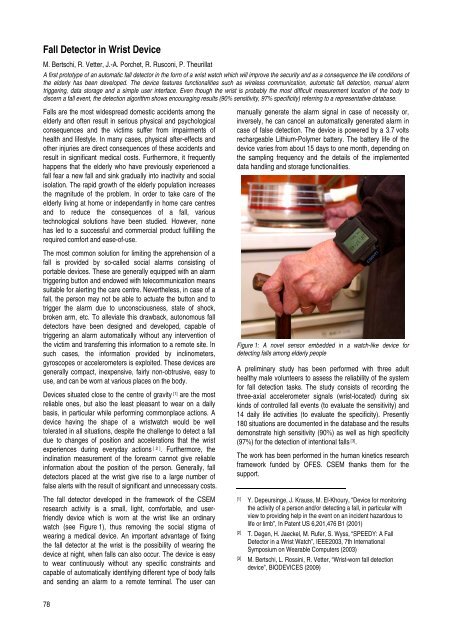CSEM Scientific and Technical Report 2008
CSEM Scientific and Technical Report 2008
CSEM Scientific and Technical Report 2008
You also want an ePaper? Increase the reach of your titles
YUMPU automatically turns print PDFs into web optimized ePapers that Google loves.
Fall Detector in Wrist Device<br />
M. Bertschi, R. Vetter, J.-A. Porchet, R. Rusconi, P. Theurillat<br />
A first prototype of an automatic fall detector in the form of a wrist watch which will improve the security <strong>and</strong> as a consequence the life conditions of<br />
the elderly has been developed. The device features functionalities such as wireless communication, automatic fall detection, manual alarm<br />
triggering, data storage <strong>and</strong> a simple user interface. Even though the wrist is probably the most difficult measurement location of the body to<br />
discern a fall event, the detection algorithm shows encouraging results (90% sensitivity, 97% specificity) referring to a representative database.<br />
Falls are the most widespread domestic accidents among the<br />
elderly <strong>and</strong> often result in serious physical <strong>and</strong> psychological<br />
consequences <strong>and</strong> the victims suffer from impairments of<br />
health <strong>and</strong> lifestyle. In many cases, physical after-effects <strong>and</strong><br />
other injuries are direct consequences of these accidents <strong>and</strong><br />
result in significant medical costs. Furthermore, it frequently<br />
happens that the elderly who have previously experienced a<br />
fall fear a new fall <strong>and</strong> sink gradually into inactivity <strong>and</strong> social<br />
isolation. The rapid growth of the elderly population increases<br />
the magnitude of the problem. In order to take care of the<br />
elderly living at home or independantly in home care centres<br />
<strong>and</strong> to reduce the consequences of a fall, various<br />
technological solutions have been studied. However, none<br />
has led to a successful <strong>and</strong> commercial product fulfilling the<br />
required comfort <strong>and</strong> ease-of-use.<br />
The most common solution for limiting the apprehension of a<br />
fall is provided by so-called social alarms consisting of<br />
portable devices. These are generally equipped with an alarm<br />
triggering button <strong>and</strong> endowed with telecommunication means<br />
suitable for alerting the care centre. Nevertheless, in case of a<br />
fall, the person may not be able to actuate the button <strong>and</strong> to<br />
trigger the alarm due to unconsciousness, state of shock,<br />
broken arm, etc. To alleviate this drawback, autonomous fall<br />
detectors have been designed <strong>and</strong> developed, capable of<br />
triggering an alarm automatically without any intervention of<br />
the victim <strong>and</strong> transferring this information to a remote site. In<br />
such cases, the information provided by inclinometers,<br />
gyroscopes or accelerometers is exploited. These devices are<br />
generally compact, inexpensive, fairly non-obtrusive, easy to<br />
use, <strong>and</strong> can be worn at various places on the body.<br />
Devices situated close to the centre of gravity [1] are the most<br />
reliable ones, but also the least pleasant to wear on a daily<br />
basis, in particular while performing commonplace actions. A<br />
device having the shape of a wristwatch would be well<br />
tolerated in all situations, despite the challenge to detect a fall<br />
due to changes of position <strong>and</strong> accelerations that the wrist<br />
experiences during everyday actions [ 2] . Furthermore, the<br />
inclination measurement of the forearm cannot give reliable<br />
information about the position of the person. Generally, fall<br />
detectors placed at the wrist give rise to a large number of<br />
false alerts with the result of significant <strong>and</strong> unnecessary costs.<br />
The fall detector developed in the framework of the <strong>CSEM</strong><br />
research activity is a small, light, comfortable, <strong>and</strong> userfriendly<br />
device which is worn at the wrist like an ordinary<br />
watch (see Figure 1), thus removing the social stigma of<br />
wearing a medical device. An important advantage of fixing<br />
the fall detector at the wrist is the possibility of wearing the<br />
device at night, when falls can also occur. The device is easy<br />
to wear continuously without any specific constraints <strong>and</strong><br />
capable of automatically identifying different type of body falls<br />
<strong>and</strong> sending an alarm to a remote terminal. The user can<br />
78<br />
manually generate the alarm signal in case of necessity or,<br />
inversely, he can cancel an automatically generated alarm in<br />
case of false detection. The device is powered by a 3.7 volts<br />
rechargeable Lithium-Polymer battery. The battery life of the<br />
device varies from about 15 days to one month, depending on<br />
the sampling frequency <strong>and</strong> the details of the implemented<br />
data h<strong>and</strong>ling <strong>and</strong> storage functionalities.<br />
Figure 1: A novel sensor embedded in a watch-like device for<br />
detecting falls among elderly people<br />
A preliminary study has been performed with three adult<br />
healthy male volunteers to assess the reliability of the system<br />
for fall detection tasks. The study consists of recording the<br />
three-axial accelerometer signals (wrist-located) during six<br />
kinds of controlled fall events (to evaluate the sensitivity) <strong>and</strong><br />
14 daily life activities (to evaluate the specificity). Presently<br />
180 situations are documented in the database <strong>and</strong> the results<br />
demonstrate high sensitivity (90%) as well as high specificity<br />
(97%) for the detection of intentional falls [3] .<br />
The work has been performed in the human kinetics research<br />
framework funded by OFES. <strong>CSEM</strong> thanks them for the<br />
support.<br />
[1] Y. Depeursinge, J. Krauss, M. El-Khoury, “Device for monitoring<br />
the activity of a person <strong>and</strong>/or detecting a fall, in particular with<br />
view to providing help in the event on an incident hazardous to<br />
life or limb”, In Patent US 6,201,476 B1 (2001)<br />
[2] T. Degen, H. Jaeckel, M. Rufer, S. Wyss, “SPEEDY: A Fall<br />
Detector in a Wrist Watch”, IEEE2003, 7th International<br />
Symposium on Wearable Computers (2003)<br />
[3] M. Bertschi, L. Rossini, R. Vetter, “Wrist-worn fall detection<br />
device”, BIODEVICES (2009)








